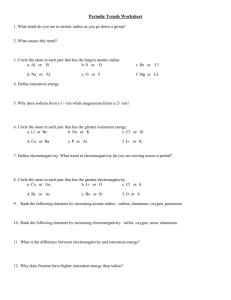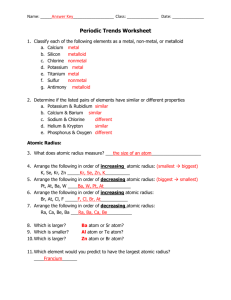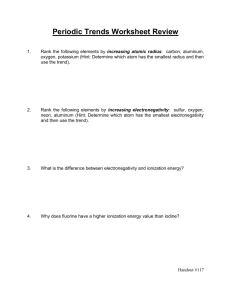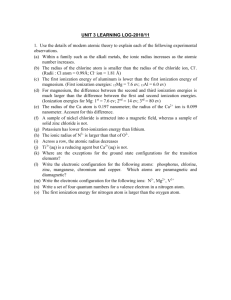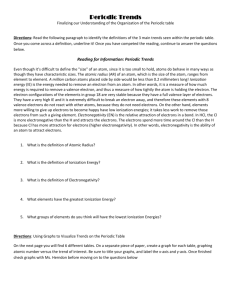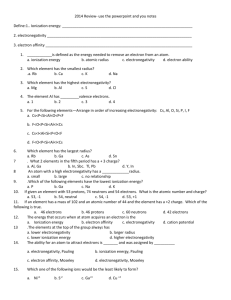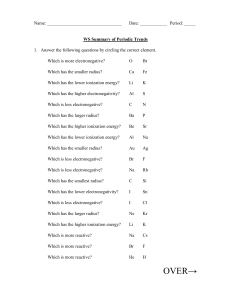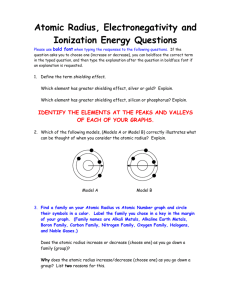Periodic Trends Worksheet Answers
advertisement
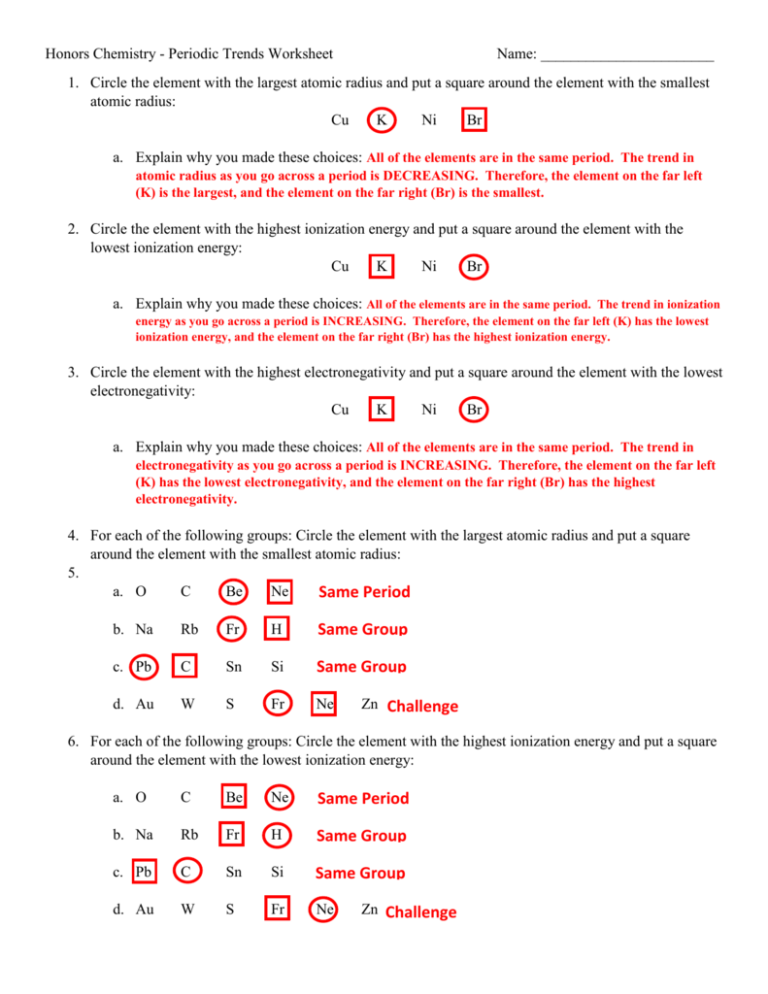
Honors Chemistry - Periodic Trends Worksheet Name: _______________________ 1. Circle the element with the largest atomic radius and put a square around the element with the smallest atomic radius: Cu K Ni Br a. Explain why you made these choices: All of the elements are in the same period. The trend in atomic radius as you go across a period is DECREASING. Therefore, the element on the far left (K) is the largest, and the element on the far right (Br) is the smallest. 2. Circle the element with the highest ionization energy and put a square around the element with the lowest ionization energy: Cu K Ni Br a. Explain why you made these choices: All of the elements are in the same period. The trend in ionization energy as you go across a period is INCREASING. Therefore, the element on the far left (K) has the lowest ionization energy, and the element on the far right (Br) has the highest ionization energy. 3. Circle the element with the highest electronegativity and put a square around the element with the lowest electronegativity: Cu K Ni Br a. Explain why you made these choices: All of the elements are in the same period. The trend in electronegativity as you go across a period is INCREASING. Therefore, the element on the far left (K) has the lowest electronegativity, and the element on the far right (Br) has the highest electronegativity. 4. For each of the following groups: Circle the element with the largest atomic radius and put a square around the element with the smallest atomic radius: 5. a. O C Be Ne Same Period b. Na Rb Fr H Same Group c. Pb C Sn Si Same Group d. Au W S Fr Ne Zn Challenge 6. For each of the following groups: Circle the element with the highest ionization energy and put a square around the element with the lowest ionization energy: a. O C Be Ne Same Period b. Na Rb Fr H Same Group c. Pb C Sn Si Same Group d. Au W S Fr Ne Zn Challenge 7. For each of the following groups: Circle the element with the highest electronegativity and put a square around the element with the lowest electronegativity: a. O C Be Ne Same Period – Don’t count Ne since it’s a Noble Gas b. Na Rb Fr H Same Group c. Pb C Sn Si Same Group d. Au W S Fr Ne Zn Challenge - Don’t count Ne since it’s a Noble Gas 8. Circle the ions that will have a radius larger than the radius of their neutral parent atom and put a square around the ions that will have a radius smaller than the radius of their neutral parent atom: Na+ Sr2+ P3- Cr3+ O2- C4- C4+ Ag+ Br- a. Explain why you made these choices: Cations (+ charge) are smaller than their parent atom because they have LOST electrons. Anions (- charge) are larger than their parent atom because they have GAINED electrons. 9. For each of the following groups, circle the ion with the largest ionic radius: a. Cu+ Cu2+ b. Cr3+ Cr2+ c. O2- O- Cu+ has lost 1 electron, whereas Cu2+ has lost 2 electrons Cr6+ Cr4+ Cr2+ has lost the fewest electrons O2- has gained 2 electrons, whereas O- has gained 1 electron 10. Rank the following elements in order of increasing atomic radius: Carbon, Aluminum, Oxygen, Potassium Oxygen < Carbon < Aluminum < Potassium 11. Rank the following elements in order of increasing electronegativity: Sulfur, Oxygen, Fluorine, Aluminum Aluminum < Sulfur < Oxygen < Fluorine 12. Rank the following elements in order of decreasing ionization energy: Lithium, Calcium, Barium, Nitrogen Nitrogen < Lithium < Calcium < Barium 13. What is the difference between ionization energy and electronegativity? Ionization energy is the energy required to remove an electron. Electronegativity is the ability of an atom to gain an electron.
